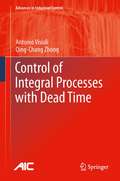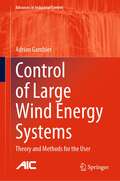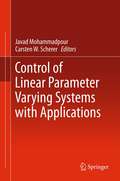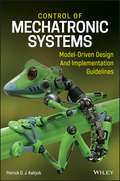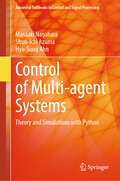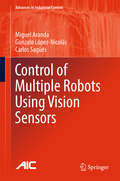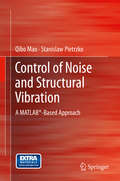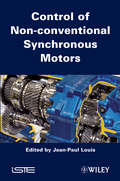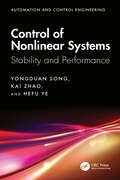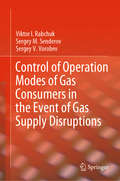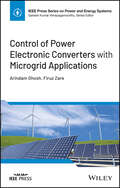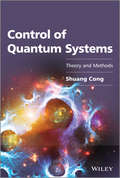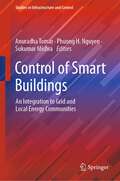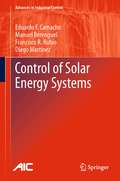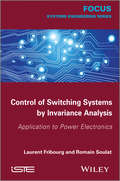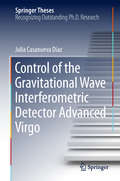- Table View
- List View
Control of Integral Processes with Dead Time (Advances in Industrial Control)
by Antonio Visioli Qingchang ZhongControl of Integral Processes with Dead Time provides a unified and coherent review of the various approaches devised for the control of integral processes, addressing the problem from different standpoints. In particular, the book treats the following topics: How to tune a PID controller and assess its performance; How to design a two-degree-of-freedom control scheme in order to deal with both the set-point following and load disturbance rejection tasks; How to modify the basic Smith predictor control scheme in order to cope with the presence of an integrator in the process; and how to address the presence of large process dead times. The methods are presented sequentially, highlighting the evolution of their rationale and implementation and thus clearly characterising them from both academic and industrial perspectives.
Control of Large Wind Energy Systems: Theory and Methods for the User (Advances in Industrial Control)
by Adrian GambierWind energy systems are central contributors to renewable energy generation, and their technology is continuously improved and updated. Without losing sight of theory, Control of Large Wind Energy Systems demonstrates how to implement concrete control systems for modern wind turbines, explaining the reasons behind choices and decisions. This book provides an extended treatment of different control topics divided into three thematic parts including modelling, control and implementation. Solutions for real-life difficulties such as multi-parameter tuning of several controllers, curve fitting of nonlinear power curves, and filter design for concrete signals are also undertaken. Examples and a case study are included to illustrate the parametrization of models, the control systems design with problems and possible solutions. Advice for the selection of control laws, calculation of specific parameters, which are necessary for the control laws, as the sensitivity functions, is given, as well as an evaluation of control performance based on indices and load calculation. Control of Large Wind Energy Systems covers methodologies which are not usually found in literature on this topic, including fractional order PID and nonlinear PID for pitch control, peak shaving control and extremum seeking control for the generator control, yaw control and shutdown control. This makes it an ideal book for postgraduate students, researchers and industrial engineers in the field of wind turbine control. Advances in Industrial Control reports and encourages the transfer of technology in control engineering. The rapid development of control technology has an impact on all areas of the control discipline. The series offers an opportunity for researchers to present an extended exposition of new work in all aspects of industrial control.
Control of Linear Parameter Varying Systems with Applications
by Carsten W. Scherer Javad MohammadpourControl of Linear Parameter Varying Systems compiles state-of-the-art contributions on novel analytical and computational methods for addressing system identification, model reduction, performance analysis and feedback control design and addresses address theoretical developments, novel computational approaches and illustrative applications to various fields. Part I discusses modeling and system identification of linear parameter varying systems, Part II covers the importance of analysis and control design when working with linear parameter varying systems (LPVS) , Finally, Part III presents an applications based approach to linear parameter varying systems, including modeling of a turbocharged diesel engines, Multivariable control of wind turbines, modeling and control of aircraft engines, control of an autonomous underwater vehicles and analysis and synthesis of re-entry vehicles.
Control of Marine Vehicles (Springer Series on Naval Architecture, Marine Engineering, Shipbuilding and Shipping #9)
by Karl Dietrich von EllenriederThis textbook offers a comprehensive introduction to the control of marine vehicles, from fundamental to advanced concepts, including robust control techniques for handling model uncertainty, environmental disturbances, and actuator limitations. Starting with an introductory chapter that extensively reviews automatic control and dynamic modeling techniques for ocean vehicles, the first part of the book presents in-depth information on the analysis and control of linear time invariant systems. The concepts discussed are developed progressively, providing a basis for understanding more complex techniques and stimulating readers’ intuition. In addition, selected examples illustrating the main concepts, the corresponding MATLAB® code, and problems are included in each chapter. In turn, the second part of the book offers comprehensive coverage on the stability and control of nonlinear systems. Following the same intuitive approach, it guides readers from the fundamentals to more advanced techniques, which culminate in integrator backstepping, adaptive and sliding mode control. Leveraging the author’s considerable teaching and research experience, the book offers a good balance of theory and stimulating questions. Not only does it provide a valuable resource for undergraduate and graduate students; it will also benefit practitioners who want to review the foundational concepts underpinning some of the latest advanced marine vehicle control techniques, for use in their own applications.
Control of Mechatronic Systems: Model-Driven Design and Implementation Guidelines
by Patrick O. KaltjobA practical methodology for designing integrated automation control for systems and processes Implementing digital control within mechanical-electronic (mechatronic) systems is essential to respond to the growing demand for high-efficiency machines and processes. In practice, the most efficient digital control often integrates time-driven and event-driven characteristics within a single control scheme. However, most of the current engineering literature on the design of digital control systems presents discrete-time systems and discrete-event systems separately. Control Of Mechatronic Systems: Model-Driven Design And Implementation Guidelines unites the two systems, revisiting the concept of automated control by presenting a unique practical methodology for whole-system integration. With its innovative hybrid approach to the modeling, analysis, and design of control systems, this text provides material for mechatronic engineering and process automation courses, as well as for self-study across engineering disciplines. Real-life design problems and automation case studies help readers transfer theory to practice, whether they are building single machines or large-scale industrial systems. Presents a novel approach to the integration of discrete-time and discrete-event systems within mechatronic systems and industrial processes Offers user-friendly self-study units, with worked examples and numerous real-world exercises in each chapter Covers a range of engineering disciplines and applies to small- and large-scale systems, for broad appeal in research and practice Provides a firm theoretical foundation allowing readers to comprehend the underlying technologies of mechatronic systems and processes Control Of Mechatronic Systems is an important text for advanced students and professionals of all levels engaged in a broad range of engineering disciplines.
Control of Microstructures and Properties in Steel Arc Welds (Materials Science & Technology #1)
by Lars-Erik SvenssonControl of Microstructures and Properties in Steel Arc Welds provides an overview of the most recent developments in welding metallurgy. Topics discussed include common welding processes, the thermal cycle during welding, defects that may occur during the welding process, the metallurgy of the material, metallurgical processes in the heat-affected zone and the fused metal, and the relationship between microstructures and mechanical properties. The book's final chapter presents examples of welded joints, illustrating how modern theories are capable of predicting the microstructure and properties of these joints. This book is an excellent resource for welding engineers, metallurgists, materials scientists, and others interested in the subject.
Control of Multi-agent Systems: Theory and Simulations with Python (Advanced Textbooks in Control and Signal Processing)
by Hyo-Sung Ahn Shun-Ichi Azuma Masaaki NagaharaThis textbook teaches control theory for multi-agent systems. Readers will learn the basics of linear algebra and graph theory, which are then developed to describe and solve multi-agent control problems. The authors address important and fundamental problems including: • consensus control; • coverage control; • formation control; • distributed optimization; and • the viral spreading phenomenon. Students' understanding of the core theory for multi-agent control is enhanced through worked examples and programs in the popular Python language. End-of-chapter exercises are provided to help assess learning progress. Instructors who adopt the book for their courses can download a solutions manual and the figures in the book for lecture slides. Additionally, the Python programs are available for download and can be used for experiments by students in advanced undergraduate or graduate courses based on this text. The broad spectrum of applications relevant to this material includes the Internet of Things, cyber-physical systems, robot swarms, communications networks, smart grids, and truck platooning. Additionally, in the spheres of social science and public health, it applies to opinion dynamics and the spreading of viruses in social networks. Students interested in learning about such applications, or in pursuing further research in multi-agent systems from a theoretical perspective, will find much to gain from Control of Multi-agent Systems. Instructors wishing to teach the subject will also find it beneficial.
Control of Multiple Robots Using Vision Sensors (Advances in Industrial Control)
by Carlos Sagüés Miguel Aranda Gonzalo López-NicolásThis monograph introduces novel methods for the control and navigation of mobile robots using multiple-1-d-view models obtained from omni-directional cameras. This approach overcomes field-of-view and robustness limitations, simultaneously enhancing accuracy and simplifying application on real platforms. The authors also address coordinated motion tasks for multiple robots, exploring different system architectures, particularly the use of multiple aerial cameras in driving robot formations on the ground. Again, this has benefits of simplicity, scalability and flexibility. Coverage includes details of: a method for visual robot homing based on a memory of omni-directional images; a novel vision-based pose stabilization methodology for non-holonomic ground robots based on sinusoidal-varying control inputs; an algorithm to recover a generic motion between two 1-d views and which does not require a third view; a novel multi-robot setup where multiple camera-carrying unmanned aerial vehicles are used to observe and control a formation of ground mobile robots; and three coordinate-free methods for decentralized mobile robot formation stabilization. The performance of the different methods is evaluated both in simulation and experimentally with real robotic platforms and vision sensors. Control of Multiple Robots Using Vision Sensors will serve both academic researchers studying visual control of single and multiple robots and robotics engineers seeking to design control systems based on visual sensors.
Control of Noise and Structural Vibration: A MATLAB®-Based Approach
by Qibo Mao Stanislaw PietrzkoControl of Noise and Structural Vibration presents a MATLAB®-based approach to solving the problems of undesirable noise generation and transmission by structures and of undesirable vibration within structures in response to environmental or operational forces. The fundamentals of acoustics, vibration and coupling between vibrating structures and the sound fields they generate are introduced including a discussion of the finite element method for vibration analysis. Following this, the treatment of sound and vibration control begins, illustrated by example systems such as beams, plates and double walls. Sensor and actuator placement is explained as is the idea of modal sensor-actuators. The design of appropriate feedback systems includes consideration of basic stability criteria and robust active structural acoustic control. Positive position feedback (PPF) and multimode control are also described in the context of loudspeaker-duct and loudspeaker-microphone models. The design of various components is detailed including the analog circuit for PPF, adaptive (semi-active) Helmholtz resonators and shunt piezoelectric circuits for noise and vibration suppression. The text makes extensive use of MATLAB® examples and these can be simulated using files available for download from the book's webpage at springer.com. End-of-chapter exercises will help readers to assimilate the material as they progress through the book. Control of Noise and Structural Vibration will be of considerable interest to the student of vibration and noise control and also to academic researchers working in the field. It's tutorial features will help practitioners who wish to update their knowledge with self-study.
Control of Non-conventional Synchronous Motors (Wiley-iste Ser.)
by Jean-Paul LouisClassical synchronous motors are the most effective device to drive industrial production systems and robots with precision and rapidity. However, numerous applications require efficient controls in non-conventional situations. Firstly, this is the case with synchronous motors supplied by thyristor line-commutated inverters, or with synchronous motors with faults on one or several phases. Secondly, many drive systems use non-conventional motors such as polyphase (more than three phases) synchronous motors, synchronous motors with double excitation, permanent magnet linear synchronous motors, synchronous and switched reluctance motors, stepping motors and piezoelectric motors. This book presents efficient controls to improve the use of these non-conventional motors. Contents 1. Self-controlled Synchronous Motor: Principles of Function and Simplified Control Model, Francis Labrique and François Baudart.2. Self-controlled Synchronous Motor: Dynamic Model Including the Behavior of Damper Windings and Commutation Overlap, Ernest Matagne.3. Synchronous Machines in Degraded Mode, Damien Flieller, Ngac Ky Nguyen, Hervé Schwab and Guy Sturtzer.4. Control of the Double-star Synchronous Machine Supplied by PWM Inverters, Mohamed Fouad Benkhoris.5. Vectorial Modeling and Control of Multiphase Machines with Non-salient Poles Supplied by an Inverter, Xavier Kestelyn and Éric Semail.6. Hybrid Excitation Synchronous Machines, Nicolas Patin and Lionel Vido.7. Advanced Control of the Linear Synchronous Motor, Ghislain Remy and Pierre-Jean Barre.8. Variable Reluctance Machines: Modeling and Control, Mickael Hilairet, Thierry Lubin and Abdelmounaïm Tounzi.9. Control of the Stepping Motor, Bruno Robert and Moez Feki .10. Control of Piezoelectric Actuators, Frédéric Giraud and Betty Lemaire-Semail.
Control of Nonlinear Systems: Stability and Performance (ISSN)
by Yongduan Song Kai Zhao Hefu YeThe book Control of Nonlinear Systems–Stability and Performance fills a crucial gap in the field of nonlinear control systems by providing a comprehensive yet accessible treatment of the subject. Unlike many existing texts that are either too complex for beginners or omit essential topics, this book strikes the right balance of mathematical rigor and practicality.The main objective of the book is to simplify and unify the existing techniques for designing and analyzing control systems for nonlinear systems. It aims to alleviate confusion and difficulty in understanding these methods, making it an invaluable resource for students, researchers, and practitioners in the field. By presenting the material in a tutorial manner, the book enhances the reader's understanding of the design and analysis of a wide range of control methods for nonlinear systems. The emphasis on stability and performance highlights the practical relevance of the concepts discussed in the book.Overall, Control of Nonlinear Systems–Stability and Performance is a valuable contribution to the field of nonlinear control systems. Its emphasis on practical applications and its accessible presentation make it an indispensable resource for engineers seeking to enhance their knowledge and skills in this important area of control theory.
Control of Nonlinear Systems via PI, PD and PID: Stability and Performance (Automation and Control Engineering)
by Yong-Duan SongThe purpose of this book is to give an exposition of recently adaptive PI/PD/PID control design for nonlinear systems. Since PI/PD/PID control is simple in structure and inexpensive in implementation, it has been undoubtedly the most widely employed controller in industry. In fact, PI/PD/PID controllers are sufficient for many control problems, particularly when process dynamics are benign and the performance requirements are modest. The book focuses on how to design general PI/PD/PID controller with self-tuning gains for different systems, which includes SISO nonlinear system, SISO nonaffine system and MIMO nonlinear system.
Control of Operation Modes of Gas Consumers in the Event of Gas Supply Disruptions
by Viktor I. Rabchuk Sergey M. Senderov Sergey V. VorobevThis book is focused on the management of gas consumers, especially in cases of gas supply disruptions. It addresses natural gas consumers from numerous different fields, including those in the industrial sector, the electric power industry, and public utilities.It highlights various ways gas supply can be affected and demonstrates the approaches that can help recovery from reduced, stopped, and restored gas deliveries. The algorithms involved in transitioning gas consumers from normal to emergency operation, and the algorithm for recovering normal operation after an emergency in the gas supply system is terminated are explored thoroughly.By clearly explaining several approaches, this book will enable specialists to more effectively manage gas-consuming enterprises in emergency situations associated with gas supply disruption
Control of Overhead Power Lines with Unmanned Aerial Vehicles (Studies in Systems, Decision and Control #359)
by Yevgen I. Sokol Artur O. ZaporozhetsThis book is devoted to the development of complex methods and means of their implementation with using UAVs aimed for improving the safety and efficiency of the energy system. The scientific problem of complex automated monitoring of the energy system objects with using UAVs has been solved, including the control of its elements in the visible and infrared range, the acoustic spectrum, as well as by the levels of the electric field strength. The scientific foundations of mathematical, physical and statistical modeling of electromagnetic and acoustic fields in the elements of electric power objects of complex spatial configurations have been created, taking into account the possibility of the appearance of such nonlinear processes as corona discharges and breakdowns at long air gaps. Improved methods are proposed for determining the exact location of accidents on power lines using UAVs on the basis of the developed mathematical models and the obtained analytical expressions. Conceptual foundations for the creation of methods and means for monitoring the state of insulation, lightning protection systems and the integrity of the structures of electric power facilities with using UAVs have been formed.
Control of Polymerization Reactors
by F. Joseph Schurk Pradeep B. Deshpande Kenneth W. Leffew Vikas M. NadkarniThis reference and text provides an in-depth description of developments in control techniques and their application to polymerization reactors and offers important introductory background information on polymerization reaction engineering.;Discussing modelling, identification, linear, nonlinear and multivariable schemes, Control of Polymerization Reactors: presents all available techniques that can be used to control reactors properly for optimal performance; shows how to manipulate pivotal variables that affect reactor control; examines methods for deriving dynamic process models to improve reactor efficiency; reviews reactor control problems and points out end-use properties; supplies methods for measuring process variables, and ways to estimate variables that can't be measured; and explains how single-input, single-output (SISO) strategies can be effectively used for control.;Filled with illustrative examples to clarify concepts, including more than 730 figures, tables and equations, Control of Polymerization Reactors is intended for use as a reference for chemical, process development, process design, research and development, control systems, and polymer engineers; and polymer chemists and physicists; as well as a text for upper-level undergraduate and graduate students in polymerization reactor control courses.
Control of Power Electronic Converters with Microgrid Applications (IEEE Press Series on Power and Energy Systems)
by Arindam Ghosh Firuz ZareControl of Power Electronic Converters with Microgrid Applications Discover a systematic approach to design controllers for power electronic converters and circuits In Control of Power Electronic Converters with Microgrid Applications, distinguished academics and authors Drs. Arindam Ghosh and Firuz Zare deliver a systematic exploration of design controllers for power electronic converters and circuits. The book offers readers the knowledge necessary to effectively design intelligent control mechanisms. It covers the theoretical requirements, like advanced control theories and the analysis and conditioning of AC signals as well as controller development and control. The authors provide readers with discussions of custom power devices, as well as both DC and AC microgrids. They also discuss the harmonic issues that are crucial in this area, as well as harmonic standardization. The book addresses a widespread lack of understanding in the control philosophy that can lead to a stable operation of converters, with a focus on the application of power electronics to power distribution systems. Readers will also benefit from the inclusion of: A thorough introduction to controller design for different power electronic converter configurations in microgrid systems (both AC and DC) A presentation of emerging technology in power distribution systems to integrate different renewable energy sources Chapters on DC-DC converters and DC microgrids, as well as DC-AC converter modulation techniques and custom power devices, predictive control, and AC microgrids Perfect for manufacturers of power converters, microgrid developers and installers, as well as consultants who work in this area, Control of Power Electronic Converters with Microgrid Applications is also an indispensable reference for graduate students, senior undergraduate students, and researchers seeking a one-stop resource for the design of controllers for power electronic converters and circuits.
Control of Power Inverters in Renewable Energy and Smart Grid Integration
by Tomas Hornik Qing-Chang ZhongIntegrating renewable energy and other distributed energy sources into smart grids, often via power inverters, is arguably the largest "new frontier" for smart grid advancements. Inverters should be controlled properly so that their integration does not jeopardize the stability and performance of power systems and a solid technical backbone is formed to facilitate other functions and services of smart grids.This unique reference offers systematic treatment of important control problems in power inverters, and different general converter theories. Starting at a basic level, it presents conventional power conversion methodologies and then 'non-conventional' methods, with a highly accessible summary of the latest developments in power inverters as well as insight into the grid connection of renewable power.Consisting of four parts - Power Quality Control, Neutral Line Provision, Power Flow Control, and Synchronisation - this book fully demonstrates the integration of control and power electronics.Key features include:the fundamentals of power processing and hardware designinnovative control strategies to systematically treat the control of power invertersextensive experimental results for most of the control strategies presentedthe pioneering work on "synchronverters" which has gained IET Highly Commended Innovation AwardEngineers working on inverter design and those at power system utilities can learn how advanced control strategies could improve system performance and work in practice. The book is a useful reference for researchers who are interested in the area of control engineering, power electronics, renewable energy and distributed generation, smart grids, flexible AC transmission systems, and power systems for more-electric aircraft and all-electric ships. This is also a handy text for graduate students and university professors in the areas of electrical power engineering, advanced control engineering, power electronics, renewable energy and smart grid integration.
Control of Quantum Systems: Theory and Methods
by Shuang CongAdvanced research reference examining the closed and open quantum systems Control of Quantum Systems: Theory and Methods provides an insight into the modern approaches to control of quantum systems evolution, with a focus on both closed and open (dissipative) quantum systems. The topic is timely covering the newest research in the field, and presents and summarizes practical methods and addresses the more theoretical aspects of control, which are of high current interest, but which are not covered at this level in other text books. The quantum control theory and methods written in the book are the results of combination of macro-control theory and microscopic quantum system features. As the development of the nanotechnology progresses, the quantum control theory and methods proposed today are expected to be useful in real quantum systems within five years. The progress of the quantum control theory and methods will promote the progress and development of quantum information, quantum computing, and quantum communication. Equips readers with the potential theories and advanced methods to solve existing problems in quantum optics/information/computing, mesoscopic systems, spin systems, superconducting devices, nano-mechanical devices, precision metrology. Ideal for researchers, academics and engineers in quantum engineering, quantum computing, quantum information, quantum communication, quantum physics, and quantum chemistry, whose research interests are quantum systems control.
Control of Salmonella and Other Bacterial Pathogens in Low-Moisture Foods
by Darryl G. Black Richard PodolakThe first and only comprehensive reference/solutions manual for managing food safety in low-moisture foods The first book devoted to an increasingly critical public health issue, Control of Salmonella and Other Bacterial Pathogens in Low-Moisture Foods reviews the current state of the science on the prevalence and persistence of bacterial pathogens in low-moisture foods and describes proven techniques for preventing food contamination for manufacturers who produce those foods. Many pathogens, such as Salmonella, due to their enhanced thermal resistance in dry environments, can survive the drying process and may persist for prolonged periods in low-moisture foods, especially when stored in refrigerated environments. Bacterial contamination of low-moisture foods, such as peanut butter, present a vexing challenge to food safety, and especially now, in the wake of widely publicized food safety related events, food processors urgently need up-to-date, practical information on proven measures for containing the risk of contamination. While much has been written on the subject, until now it was scattered throughout the world literature in scientific and industry journals. The need for a comprehensive treatment of the subject has never been greater, and now this book satisfies that need. Discusses a wide variety of foods and evaluates multiple processing platforms from the standpoint of process validation of all food safety objectives for finished food products Takes a practical approach integrating the latest scientific and technological advances in a handy working resource Presents all known sources and risk factors for pathogenic bacteria of concern in the manufacturing environment for low-moisture/water activity products Characterizes the persistence and thermal resistance of bacterial pathogens in both the environment and most low-moisture food products Control of Salmonella and Other Bacterial Pathogens in Low-Moisture Foods is a much-needed resource for food microbiologists and food industry scientists, as well as managers and executives in companies that produce and use low-moisture foods. It also belongs on the reference shelves of food safety regulatory agencies worldwide.
Control of Series-Parallel Conversion Systems (CPSS Power Electronics)
by Xinbo Ruan Wu Chen Tianzhi Fang Kai Zhuang Tao Zhang Hong YanSeries-parallel conversion systems, in which multiple standardized converter modules are connected in series or parallel at the input and output sides, to meet the demands of various applications. This book focuses on the control strategies for the series-parallel conversion systems with DC-DC converters and DC-AC inverters as the basic modules, respectively, to achieve input voltage/current sharing and output voltage/current sharing among the constituent modules. The detailed theoretical analysis with design examples and experimental validations are presented. This book is essential and valuable reference for graduate students and academics majoring in power electronics and engineers engaged in developing DC-DC converters, DC-AC inverters and power electronics transformers.
Control of Smart Buildings: An Integration to Grid and Local Energy Communities (Studies in Infrastructure and Control)
by Anuradha Tomar Phuong H. Nguyen Sukumar MishraThis book provides an overview of how efficient building energy management can be done, considering the increasing importance of renewable energy integration. It also includes the grid-interactive building, their control, energy management, and optimization techniques to promote better understanding among researchers and business professionals in the utility sector and across industries. This book is written and edited by leading specialists active in concurrent developments in smart building management, renewable energy research, and application-driven R&D. The experiences and research work shared help the readers in enhancing their knowledge in the field of renewable energy, power engineering, building energy management, demand, and supply management and learn the technical analysis of the same in an insightful manner. Additionally, established and emerging applications related to applied areas like smart cities, the Internet of things, machine learning, artificial intelligence, etc., are developed and utilized to demonstrate recent innovations in smart building energy management.
Control of Solar Energy Systems (Advances in Industrial Control)
by Manuel Berenguel Diego Martínez Eduardo F. Camacho Francisco R. RubioControl of Solar Energy Systems details the main solar energy systems, problems involved with their control, and how control systems can help in increasing their efficiency. Thermal energy systems are explored in depth, as are photovoltaic generation and other solar energy applications such as solar furnaces and solar refrigeration systems. This second and updated edition of Advanced Control of Solar Plants includes new material on: solar towers and solar tracking; heliostat calibration, characterization and offset correction; solar radiation, estimation, prediction, and computation; and integrated control of solar plants. This new edition contains worked examples in the text as well as proposed exercises and simulation models and so will be of great use to the student and academic, as well as the industrial practitioner.
Control of Surge in Centrifugal Compressors by Active Magnetic Bearings: Theory and Implementation (Advances in Industrial Control)
by Paul E. Allaire Zongli Lin Se Young YoonSurge Control of Active-magnetic-bearing-suspended Centrifugal Compressors sets out the fundamentals of integrating active magnetic bearing (AMB) rotor suspension technology in compressor systems, and describes how this relatively new bearing technology can be employed in active control of compressor surge initiation. The authors provide a self-contained and comprehensive review of rotordynamics and the fundamentals of AMB technology. The active stabilization of compressor surge employing AMBs in a machine is fully explored, from modeling of instability and controller design, to the implementation and experimental testing of the control algorithm in a specially-constructed, industrial-size centrifugal compression system. The results of these tests demonstrate the great potential of the new surge control method suggested in this text. This book will be useful for engineers in industries that involve turbocompressors and magnetic bearings, as well as for researchers and graduate students in the field of applied control. Whatever their level of experience, engineers working in the fields of turbomachinery, magnetic bearings, rotordynamics and controls will find the material in this book absorbing as all these important aspects of engineering are integrated to create a multi-disciplinary solution to a real-life industrial problem and the book is a suitable introduction to the area for newcomers.
Control of Switching Systems by Invariance Analysis: Applcation to Power Electronics (Focus Ser.)
by Laurent Fribourg Romain SoulatThis book presents correct-by-design control techniques for switching systems, using different methods of stability analysis. Switching systems are increasingly used in the electronics and mechanical industries; in power electronics and the automotive industry, for example. This is due to their flexibility and simplicity in accurately controlling industrial mechanisms. By adopting appropriate control rules, we can steer a switching system to a region centered at a desired equilibrium point, while avoiding “unsafe” regions of parameter saturation. The authors explain various correct-by-design methods for control synthesis, using different methods of stability and invariance analysis. They also provide several applications of these methods to industrial examples of power electronics. Contents 1. Control Theory: Basic Concepts. 2. Sampled Switched Systems. 3. Safety Controllers. 4. Stability Controllers. 5. Application to Multilevel Converters. 6. Other Issues: Reachability, Sensitivity, Robustness and Nonlinearity. About the Authors Laurent Fribourg is head of the LSV (Laboratoire Spécification et Vérification) and Scientific Coordinator of the Institut Farman, Institut Fédératif de Recherche CNRS, which brings together the expertise of five laboratories from ENS Cachan, in France, in the fields of modeling, simulation and validation of complex systems. He has published over 70 articles in international journals and reviewed proceedings of international conferences, in the domain of the theory of formal methods and their industrial applications. Romain Soulat is in the third year of his doctorate at the LSV at ENS Cachan in France, under the supervision of Laurent Fribourg. He is working on the modeling and verification of hybrid systems. In particular, his interests concern robustness in scheduling problems – especially as part of a collaborative project with EADS Astrium on the verification of a component in the launcher for the future Ariane 6 rocket. He has published 5 articles in reviewed proceedings of international conferences.
Control of the Gravitational Wave Interferometric Detector Advanced Virgo (Springer Theses)
by Julia Casanueva DiazThis book focuses on the development and implementation of the longitudinal, angular and frequency controls of the Advanced Virgo detector, both from the simulation and experimental point of view, which contributed to Virgo reaching a sensitivity that enabled it to join the LIGO-Virgo O2 run in August 2017. This data taking was very successful, with the first direct detection of a binary black hole merger (GW170814) using the full network of three interferometers, and the first detection and localization of a binary neutron star merger (GW170817). The second generation of gravitational wave detector, Advanced Virgo, is capable of detecting differential displacements of the order of 10–21m. This means that it is highly sensitive to any disturbance, including the seismic movement of the Earth. For this reason an active control is necessary to keep the detector in place with sufficient accuracy.
